Makin Island Raid: Difference between revisions
Pbcjohnston (talk | contribs) Formatted pictures |
Pbcjohnston (talk | contribs) Finished formatting |
||
| Line 26: | Line 26: | ||
[[File:Nautilus Makin Island 2.jpg|left|500px]] | [[File:Nautilus Makin Island 2.jpg|left|500px]] | ||
<div style="text-align: justify;"><span style="color:#00008B"> | <div style="text-align: justify;"><span style="color:#00008B">Sgt. Walter Carroll and Pfc. Dean Winters in Nautilus' crew's mess prior to the landing. A Nautilus crewmen stands at the right. The Marine on the left is standing before a deck access ladder, probably in the crew's mess. Carroll's status is not known. Winter survived the raid after a harrowing adventure, almost missing the Nautilus. He is in the photo below. | ||
<small>U.S. Navy photo</small> | <small>U.S. Navy photo</small> | ||
| Line 42: | Line 42: | ||
[[File:Nautilus Makin Island 4.jpg|left|500px]] | [[File:Nautilus Makin Island 4.jpg|left|500px]] | ||
<div style="text-align: justify;"><span style="color:#00008B">Marines in the crew's mess of Nautilus after the raid. The Marine holding the Japanese rifle | <div style="text-align: justify;"><span style="color:#00008B">Marines in the crew's mess of Nautilus after the raid. The Marine holding the Japanese rifle is Pfc. Dean Winters, seen in the photo above. The rifle is an Arisaka Type 99 7.7mm. It is a bolt action rifle with a 5-round internal box magazine. It was the standard rifle of the Japanese armed services for most of the war. Webmaster David Johnston has an example in his personal possession. It was an excellent weapon when first developed in the late 1930's, but its design was reflective of the Japanese adherence to tradition. The bolt action limited the rate of fire and the magazine had to be reloaded round by round. It had an awkward dust cover over the bolt when closed, and working the action caused this dust cover to make a distinctive noise that would give away the shooter's position. The safety was an odd twist type, instead of the more accepted lever type. It was also long and heavy and awkward to carry in combat, especially for shorter men in jungle environments. It was far outclassed by the U.S. military's M1 Garand. | ||
Interior photos of Nautilus are very rare. Despite its size it was still tight quarters, especially with 200+ Marines aboard. | Interior photos of Nautilus are very rare. Despite its size it was still tight quarters, especially with 200+ Marines aboard. | ||
| Line 97: | Line 97: | ||
[[File:Nautilus Makin Island 10.jpg|left|500px]] | [[File:Nautilus Makin Island 10.jpg|left|500px]] | ||
<div style="text-align: justify;"><span style="color:#00008B">Crew and Marines muster on deck as the "Brass" show up to welcome everyone home. Admiral Chester Nimitz stands amid a group of probably squadron and division commanders and aides. | <div style="text-align: justify;"><span style="color:#00008B">Crew and Marines muster on deck as the "Brass" show up to welcome everyone home. Admiral Chester Nimitz, Commander-in-Chief Pacific Fleet (CINCPACFLT) stands in the center amid a group of probably squadron and division commanders and aides. On the left wearing the garrison cap is LtCol Carlson. Next to the right is most likely Submarine Squadron Four C.O., Commander John H. "Babe" Brown, Jr. Nautilus was assigned to SubRon 4. The Marine wearing the helmet with his back to the camera is not known, but it is possible that he is Captain James Roosevelt, one of Carlson's officers and the son of President Franklin Roosevelt. The officer facing Nimitz with the sunglasses in unknown. On the far right the officer looking at the camera is Rear Admiral Robert H. English, Commander Submarine Force Pacific Fleet (COMSUBPAC). | ||
LtCol. | |||
<small>U.S. Navy photo</small> | <small>U.S. Navy photo</small> | ||
| Line 121: | Line 119: | ||
[[File:Red bar sub new 2.jpg]] | [[File:Red bar sub new 2.jpg]] | ||
[[File:Argonaut makin-3.jpg|left|500px]] | |||
<div style="text-align: justify;"><span style="color:#00008B">A Marine Raider, injured during the Makin operation, is lifted through a hatch on the Argonaut to be taken ashore at Pearl Harbor, 26 August 1942. Though the crew are being as careful as they can the man is in obvious pain from his injuries. Submarine hatches are not made for easy removal of the injured. It is interesting to note that a civilian is assisting with the Marine's removal. Perhaps he is a civilian doctor, as military doctors may have been in short supply at that point in the war. It is also possible that he was a newspaper man who was covering the event and he pitched in to help. | |||
<small>National Archives photo</small> | |||
[[File:Red bar sub new 2.jpg]] | |||
[[File:Nautilus Makin Island 8.jpg|left|500px]] | |||
<div style="text-align: justify;"><span style="color:#00008B">A Nautilus crewman paints a rising sun and a hash mark on one of the two 6 inch/53 caliber deck guns representing the vessels believed to be sunk at Makin Island with her guns. at least one small freighter and a patrol boat were hit in the action by Nautilus' gunnery, but later analysis could not confirm that either sank. | |||
<small>U.S. Navy photo</small> | |||
[[File:Red bar sub new 2.jpg]] | |||
<center>[[V-class|Return to the V-class page]] | [[Submarine Classes|Return to the Submarine Classes page]]</center> | <center>[[V-class|Return to the V-class page]] | [[Submarine Classes|Return to the Submarine Classes page]]</center> | ||
[[File:Red bar sub new 2.jpg]] | [[File:Red bar sub new 2.jpg]] | ||
Revision as of 13:35, 25 June 2023
Notes
Companies A and B of the 2nd Marine Raider Battalion were chosen for the raid, a total of 211 men. They were led by the charismatic LtCol Evans F. Carlson, a WWI, Nicaragua, and China veteran. One of Carlson's officers was Captain James Roosevelt, son of the President. Secrecy was important, so the plan had the Raiders transported to Makin on two of the huge old V-boats, Nautilus (SS-168) and Argonaut (SM-1). After a short period of periscope beach reconnaissance, the Marines were to be landed via outboard engine powered rubber inflatable boats. Once ashore they were to engage and kill as many of the Japanese garrison troops as possible, take prisoners if feasible, gather intelligence, and destroy any military facilities. The submarines got underway from Pearl Harbor on August 8, 1942 (the day after the Guadalcanal landings) and arrived off Makin on August 16. The assault was planned for the next morning.
The Marines encountered considerable difficulties in embarking on the rubber boats from the side of the rolling submarines. Boats were overturned and engines swamped. They eventually headed off to the beach, got reorganized, and attacked their objectives. Nautilus stood by in support, lobbing 65 rounds from her big 6-inch guns into the lagoon, striking a small freighter and a patrol craft, although later analysis could not confirm any sinkings. The return to the submarines after the raid was equally chaotic, requiring significant effort and risk by both the Marines and the submarine crews. In the end, 30 Marines were not accounted for and believed dead (in fact, nine were still alive and were captured; they were later executed). The submarines set sail for Hawaii, carefully tending to numerous wounded Marines. They arrived in Pearl Harbor to a hero's welcome.
While over half of the Japanese garrison was killed by the Raiders and valuable experience in amphibious landings was obtained, the raid for the most part did not achieve its objectives. The Japanese did not take the bait and little if any enemy forces were diverted from the Solomons. In fact, realizing their vulnerabilities in the Marshalls, the Japanese reinforced all of the island garrisons there, turning the later invasion of Tarawa into a bloodbath and a Marine legend. The final legacy of the raid is mixed, and historians have debated this point for decades. For further information, we encourage you to read the articles at the links below:
●Seventy Years Ago: The Makin Island Raid, August 1942
●The Makin Island Raid: What Really Happened to the Marines?
●The Makin Island Raid

U.S. Navy photo
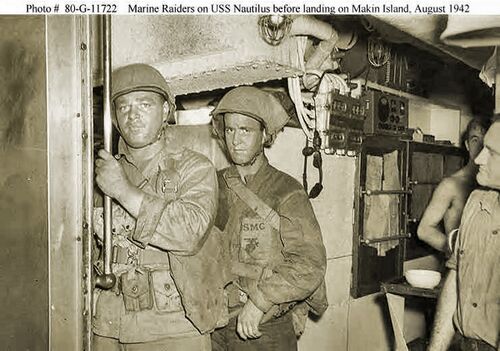
U.S. Navy photo
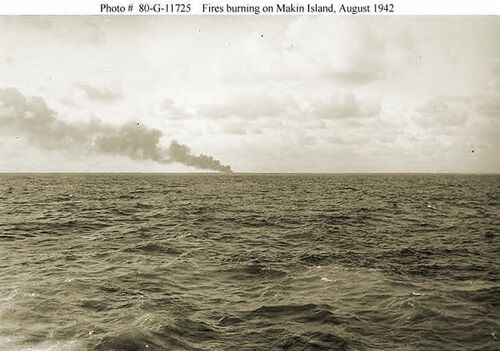
At 0703 AM she provided gunfire support against enemy positions on Ukiangong Point and then shelled the enemy ships in the lagoon. At 1039, an enemy plane appeared and Nautilus dove. Two aerial attacks followed at 1130 and another at 1255 keeping her down.
U.S. Navy photo
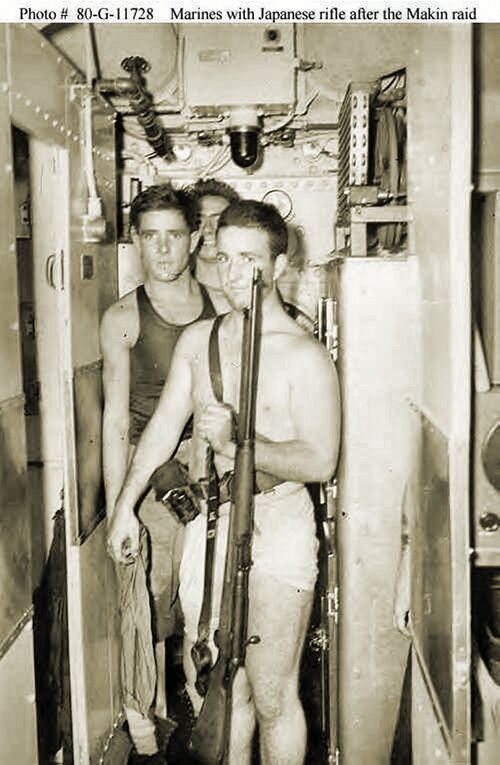
Interior photos of Nautilus are very rare. Despite its size it was still tight quarters, especially with 200+ Marines aboard.
U.S. Navy photo

After the raid Japanese records say that of the 71 Japanese on the island only 27 were alive when reinforcements arrived.
U.S. Navy photo
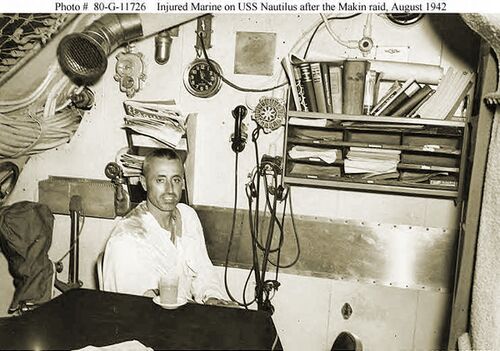
U.S. Navy photo
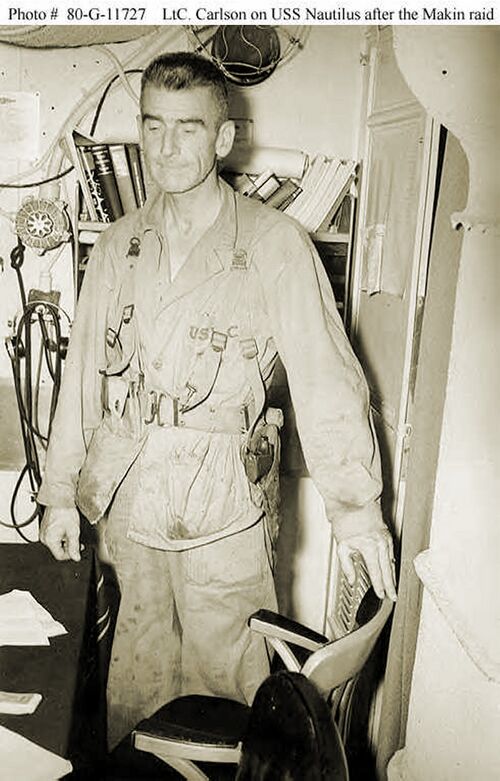
U.S. Navy photo
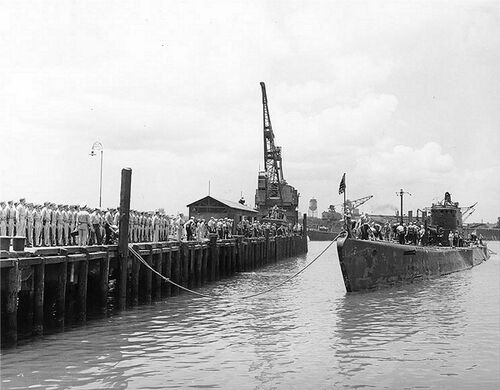
Between the end of the dock and the bow of Argonaut you can see the bow of the Nautilus, headed to the opposite side of the pier. A Marine honor guard is on the pier along with a Navy Band and the Commander-in-Chief in the Pacific, Admiral Chester W. Nimitz, USN.
National Archives photo
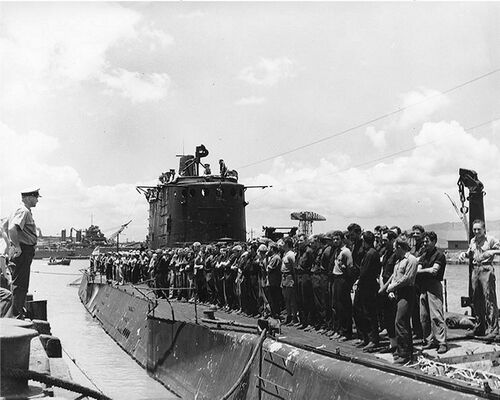
National Archives photo
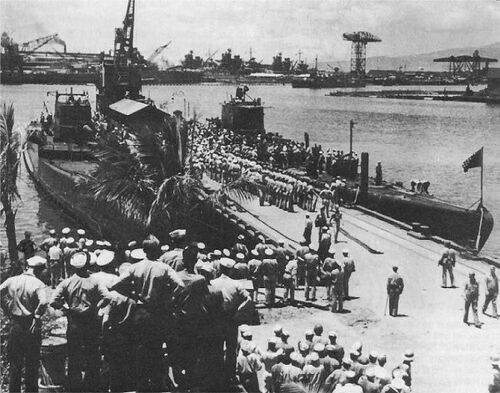
Photo courtesy of Robert Hurst via Navsource.org

U.S. Navy photo
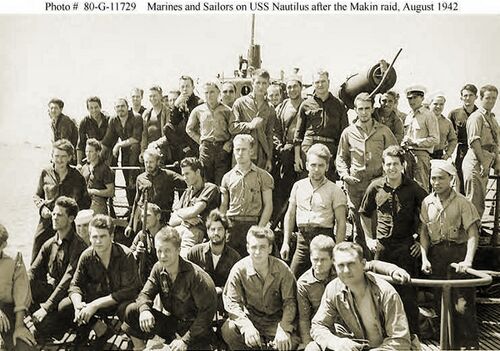
Middle row all the way to the right is one of the two Filipino Stewardsmates. There was also an African American Mess Attendant assigned to the submarine.
U.S. Navy photo
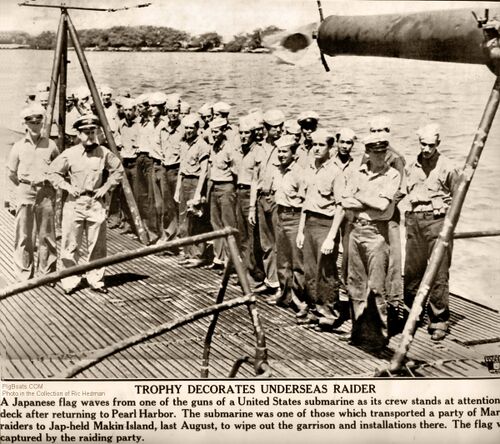
Photo in the private collection of Ric Hedman

National Archives photo

U.S. Navy photo
Page created by:
Ric Hedman & David Johnston
1999 - 2023 - PigBoats.COM©
Mountlake Terrace, WA, Norfolk, VA
webmaster at pigboats dot com
